Hydrography
Huerva river crosses the municipality of Mainar, which forms the border with the town of Villarreal de Huerva.
There is also the Villarroya stream (known Valsáuco on many maps) and Villarpardo stream. two streams, although geographically known as they are not geologically because they are the result of human activity. They were created the twelfth and thirteenth centuries in drainage channels (grooves) excessively wet, and therefore are not suitable for cultivation. This can be checked by looking at the long straight sections prospective currents and perfect angles and even the cobblestones of the current in many sections, it is instead of "El Alcocer" where the artificial production is the most obvious.
The Villarpardo stream is excavated in part by differential erosion and partly by human labor between conglomerates (known as "guijo" "gravel" or "pebble") of the limestone left and right bank. Receives by the left the Rambla (the river), which in turn receives the ravine Valdelacebo left; and gets right to the gorges and Carralanga Carramanchones.
The creek receives the right Sisones the throat; and left the Cañada (throat) Alegría del Tío, the Cañada del Moro (which in turn receives the Cañada de la Vina) and the Cañada del Gordo.
In addition, there are also several irrigation canals (the acequias [irrigation ditches] "Los Ojos" and "El Reajo"); in fact, two small drainage channels, which prevents the water is used for irrigation.
An example of irrigation created exclusively for irrigation canal is the Agua Somera Somera or Vega ( "shallow" and "superficial plain"), probably from medieval times.
Special mention are the ravines ( "Barrancos") running in the town, the most important are those that flow into the Huerva river on its left bank: Barranco de la Fuente del Piojo, Barranco del Ontazo Barranco del Pozo Ropera ( formed by the union of the Barranco de los Bodegones with Dehesilla Barranco) Barranco del Despeñadero (formed by the union of the Barranco del Molinillo and Barranco Oscuro) and Barranco de Valdefrasno.
Most of them were once for the water, but after the forest policy of the former regime, excess pines touched the main flow of the currents, and it is rare that the currents have a lot of water after the spring.
History
Although Mainar existed before the twelfth century the first mention of Mainar in history are those of the repopulation of Alfonso the Battler and Pamplona, we are not Islamic and pre-Islamic very little new in the region. Most of the part of the present municipality witnessed the wanderings of San Iñigo, confessor Sancho III Major and it is well documented that withdrew into the mountains Tobed. The etymology of Mainar is clear, which is confusing because the name was chosen precisely. Mainar is a participle of a visigothic irregular verb "magan, main" which means "take heart on the battlefield."
Mainar was a member of the Community of Daroca Villages from 1248 until the dissolution of the same in 1833 with the formation of the current provincial division. So he shared the same historical events that shook the entire region.
He suffered the agitations of the Carlist wars strongly enough because the surrounding mountains were favorable for the guerrillas to hide.
He also suffered the turmoil of the Civil War (1936-1939).
Just a few years Mainar has become part of the new regional structure known as the Campo de Daroca. Its mayor is Esmeraldo Marzo, one of the former mayors of Aragon, old "dinosaur" of the policy, regime changes have not affected him so that he has been able to stay in power since 1979.
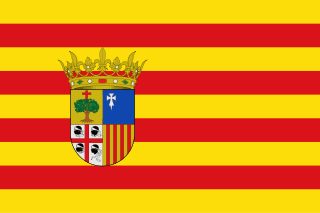
Aragon is an autonomous community in Spain, coextensive with the medieval Kingdom of Aragon. Located in northeastern Spain, the Aragonese autonomous community comprises three provinces : Huesca, Zaragoza, and Teruel. Its capital is Zaragoza. The current Statute of Autonomy declares Aragon a historic nationality of Spain.

Zaragoza is the capital city of the Zaragoza province and of the autonomous community of Aragon, Spain. It lies by the Ebro river and its tributaries, the Huerva and the Gállego, roughly in the center of both Aragon and the Ebro basin.

Benabarre, in Ribagorçan and Aragonese: Benavarri is a town and municipality in the Aragonese comarca of Ribagorza, in the province of Huesca, Spain.

Arcos de la Frontera is a town and municipality in the Sierra de Cádiz comarca, province of Cádiz, in Andalusia, Spain. It is located on the Northern, Western and Southern banks of the Guadalete river, which flows around three sides of the city under towering vertical cliffs, to Jerez and on to the Bay of Cádiz. The town commands a fine vista atop a sandstone ridge, from which the peak of San Cristóbal and the Guadalete Valley can be seen. The town gained its name by being the frontier of Spain's 13th century battle with the Moors.

Caspe is a municipality in the province of Zaragoza, part of the autonomous community of Aragón (Spain), capital of the Bajo Aragón-Caspe. It has a population of 9,525 inhabitants and its municipality, of 503.33 km², is the fourth largest in Aragon.
Bartolomé Bermejo was a Spanish painter who adopted Flemish painting techniques and conventions. Born in Cordoba, he is known for his work in the Crown of Aragon, including the Principality of Catalonia and the Kingdom of Valencia. His real name was Bartolomé de Cárdenas: the name Bermejo, which means auburn in Spanish, possibly relates to his hair colour. Bermejo may relate also to his name, Cardenas; Cardeno means purplish.
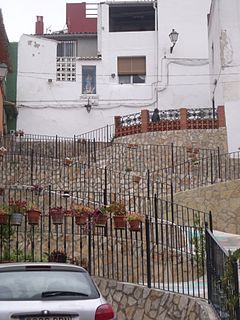
Chella is a municipality in the comarca of Canal de Navarrés in the Valencian Community, Spain.

Montcada, is a municipality in the comarca of Horta Nord in the Valencian Community, Spain.

Moros is a municipality in the province of Zaragoza, Aragon. Its population was 478 in 2006.
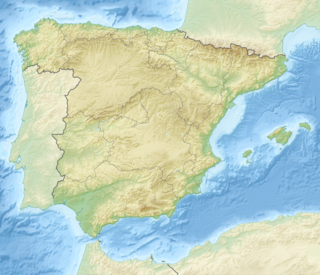
Torrijo del Campo is a municipality located in the province of Teruel, Aragon, Spain. According to the 2018 census (INE), the municipality has a population of 447 inhabitants.

Urrea de Gaén is a municipality located in the province of Teruel, community of Aragon, Spain. According to the 2004 census (INE), the municipality has a population of 568 inhabitants.

Alhama de Aragón is a spa town located in the province of Zaragoza, Aragon, Spain, situated on the river Jalón, a tributary of the Ebro. According to the 2004 census (INE), the municipality has a population of 1,150 inhabitants.

Manchones is a municipality in the province of Zaragoza, Aragon, Spain. According to the Spanish Statistical Institute (INE), the municipality had a population of 123 inhabitants in 2010. The pueblo is in the comarca of Campo de Daroca, about 6 kilometres (3.7 mi) northwest of Daroca and just southeast of Murero in the Calatayud-Daroca depression. The Jiloca River passes to the west.

Torralbilla is a municipality located in the province of Zaragoza, Aragon, Spain. According to the 2004 census (INE), the municipality has a population of 71.

Villadoz is a municipality located in the province of Zaragoza, Aragon, Spain. According to the 2010 census, the municipality has a population of 83 inhabitants.

Damià Forment was a Valencian Spanish architect and sculptor, considered the most important Spanish sculptor of the 16th century.
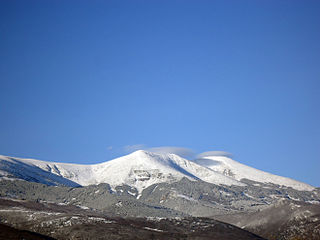
The Iberian System, is one of the major systems of mountain ranges in Spain. It consists of a vast and complex area of mostly relatively high and rugged mountain chains and massifs located in the central region of the Iberian Peninsula, but reaching almost the Mediterranean coast in the Valencian Community in the east.
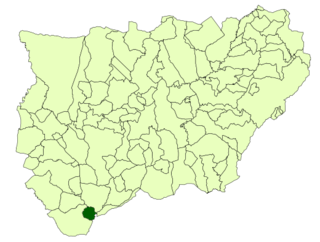
Frailes is a municipality in the Spanish province of Jaén, autonomous community of Andalucia, with a total area of 41,37 km2, a population of 1775 inhabitants and a population density of 43,41 inhab/ km2. It has been immortalised by the British writer, Michael Jacobs, in his 2003 book, The Factory of Light.

Campo de Daroca is one of the comarcas of Aragon, in the Province of Zaragoza, Aragon, Spain. It is located in the mountainous Iberian System area.

The Guayadeque ravine, in Spanish Barranco de Guayadeque, is a ravine-type valley located on the Spanish municipalities of Ingenio and Agüimes, in the province of Las Palmas on Grand Canary island, off the coast of Morocco.


















